Gobierno de la ciudad de Buenos Aires
Hospital Neuropsiquiátrico
"Dr. José Tiburcio Borda"
Laboratorio de Investigaciones Electroneurobiológicas
y
Revista
Electroneurobiología
ISSN: ONLINE 1850-1826 - PRINT 0328-0446

Modern Myths Concerning Life on Mars
by

Gilbert V. Levin*
BioSpherix Division, Spherix
Incorporated, Annapolis, MD 21401, USA
Contact: glevin@spherix.com;
phone 410-224-3319; fax 410-224-3010
Electroneurobiología 2006; 14 (5), pp. 3-25; URL <http://electroneubio.secyt.gov.ar/index2.htm>
Copyright
© November 2006 Electroneurobiología. Esta texto es un artículo de
acceso público; su copia exacta y redistribución por cualquier medio están
permitidas bajo la condición de conservar esta noticia y la referencia completa
a su publicación incluyendo la URL (ver arriba). / This is an Open Access
article: verbatim copying and redistribution of this article are permitted in
all media for any purpose, provided this notice is preserved along with the
article's full citation and URL (above).
Puede obtener un archivo .PDF (recomendado: 3,4 MB) o .DOC (1,8 MB) para leer o imprimir este artículo, desde aquí
o de / You can download a .PDF (recommended: 3.4 MB) or .DOC (1.8 MB) file for reading or printing, either from here
or from http://electroneubio.secyt.gov.ar/index2.html
Table of Contents
1. Introduction
3. The Viking Labeled Release Experiment
4. The LR Pedigree
5. The LR on Mars
6. The Standard Model Specific Obstacles
Raised and Rebuttals
7. The Present Situation
8. Future Life Detection Experiments
9. Recommendations
ABSTRACT: July 30, 2006 was the 30th
anniversary of the Viking Mission’s first Labeled Release (LR) life detection
experiment on Mars. The strong response,
together with supporting results from eight additional LR tests of Martian
soil, established the presence of an active agent that was inhibited by
heating. The data satisfied the
pre-mission criteria for the detection of living microorganisms. However, the scientific community reacted
cautiously, generally concluding that the activity in the soil was caused by
chemistry or physics.
Over the last
three decades, investigation of Mars has greatly increased. Soil, rock, and atmospheric analyses have
been made. Multi-spectral observations
have been made from Mars and Earth orbits and from Earth-based telescopes. Knowledge of extreme habitats on Earth and
bizarre life forms that populate them has increased dramatically. However, this
vast amount of new astrobiological information has yet to be integrated into an
objective scientific evaluation of the LR results and the possibilities for
life on Mars. Indeed, in part upon
misinterpretations of the new findings, myths have been embedded into the scientific
literature of Mars.
Based on these
myths as key ingredients, a false “standard model” of Martian life potential
has been developed. It has been accepted
by much of the astrobiological community, and, through its endorsement, the
world at large. This paper attempts to
bring the supportable facts together in calling for a revision of the current
consensus regarding life on Mars. It
recommends actions to facilitate the paradigm change.
Key words: Life on Mars, astrobiology, extreme
habitats, Viking mission Labeled Release experiment, Martian environment, water
on Mars
śť
1. INTRODUCTION
July 30, 2006 marked the 30th anniversary of the
Viking Mission’s first Labeled Release (LR) life detection experiment on
Mars. Its strongly positive response
established the presence of an active agent(s) in the Martian soil. In subsequent runs, the response from the
soil was shown to be eliminated or substantially reduced by heating or by
months-long storage in the dark at about 10o C, within the Martian
ambient surface temperature.[1] Similar responses were obtained at the two
Viking landing sites some 4,000 miles apart.
The data satisfied and, through improvised additional LR sequences,
exceeded the pre-mission criteria set for the detection of living
microorganisms. However, the results
were treated very cautiously, and the general scientific community concluded
that the activity in the soil was chemical or physical, rather than biological.
Over the last three decades, the scientific investigation of
Mars has greatly increased. Soil, rock
and atmospheric analyses have been made on Mars. Multi-spectral observations have been made
from orbit, and telescopic observations made from Earth. Our knowledge concerning extreme habitats on
Earth and bizarre life forms that inhabit them has increased dramatically. However, this vast amount of new
astrobiological information has yet to be integrated into a scientific
evaluation of the possibilities and prospects for life on Mars. Indeed, despite these recent findings, and,
in part, based upon their misinterpretations, a demonstrably erroneous
“standard model” for Martian life has been developed. The model has been accepted by much of the
astrobiological community, and, through its endorsement, the world at
large. This paper attempts to bring
together the relevant discrete findings about life on Mars, and justify a
revision of the current consensus.
2.
THE STANDARD MODEL
The
generally accepted “standard model” for life on Mars postulates:
·
The surface of Mars is inimical to extant life because of the
absence of liquid water, the intense UV flux and an ubiquitous layer of highly
oxidizing chemical(s).
·
The absence of organic matter in the surface material is
proof of the oxidizing layer and/or the effect of the UV flux, and of the
absence of life.
·
Life may have existed on the surface in the geological past
when conditions were more hospitable.
·
Extant life may inhabit underground oases where there is
liquid water and environmental conditions provide a favorable habitat.
Any claim to the
detection of life on Mars must deal with each of the obstacles posed by this
model and relevant corollaries resulting there from. This paper will attempt to show that the
Standard Model and its corollaries, comprising the “Modern Myths of Mars,” are
not supported in fact.
3.
THE VIKING LABELED RELEASE EXPERIMENT
Because life is the most complex phenomenon, the detection of
any chemical on Mars is unlikely to be accepted as proof of life. Therefore, the demonstration of active metabolism was the basis of the LR life detection experiment. A simple diagram of the experiment is shown
in Figure 1.
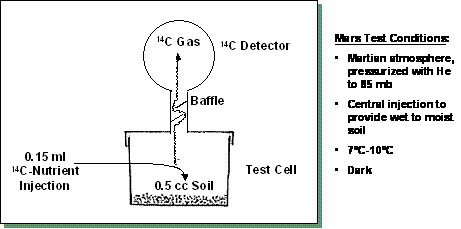
FIGURE 1. Schematic of the Viking Labeled Release experiment
The nutrients were selected for the LR based on theory and
experiment. All the nutrients, or
substrates, were simple Miller-Urey molecular compounds believed to have formed
early on primitive Earth and, therefore, likely to have been incorporated into
the earliest life forms, and probably retained throughout their evolutionary
process. Each candidate nutrient was
uniformly tagged with 14C.
Those nutrients having optical isomers were included as racemic mixtures
to make either stereoisomer available to potential Martian life. The nutrients were used in minimal
concentrations in pure aqueous solution to preclude possible toxicity as
sometimes occurs when microorganisms are overly dosed with organic and/or
inorganic matter. Table 1 presents the
LR nutrients showing their concentrations and activities.
TABLE 1. Labeled
Release Nutrients
|
|
Structure
and |
|
|
Specific
Activity |
|
14C-glycine |
NH3·*CH2·*COOH |
2.5
× 10-4M |
4 |
16 |
*Total = 34 μCi, which yields 6.8 × 107 dpm ml-1
Thousands of tests were made on microbial species, covering
all types available: pure cultures, mixed cultures and soils; and many field
tests of soils were conducted over a wide range of environments during the twenty
years of development of the LR. Examples
of field tests made with the early “sticky string” version of the instrument,
which ejected and reeled in a silicone-covered string to collect its sample,
are shown in Figures 2 to 4. False
positives were never obtained from sterilized samples. Certainty of response from living organisms,
sensitivity[2]
(to as little as ~30 cells/g), and rapidity of response provided a high level
of confidence in the experiment.
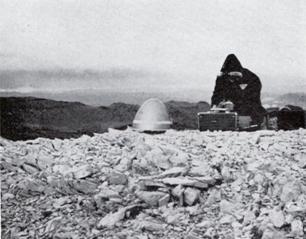
FIGURE 2. LR Test at 12,000 Ft. (above timberline) on
White Mountain, CA

FIGURE 3 (left). LR test on Death Valley sand dune
FIGURE 4 (right). LR “Sticky String” test on
Salton Sea desert flats
4.
THE LR PEDIGREE
An unsolicited proposal to develop the LR (originally
“Gulliver”) experiment was submitted to NASA in 1958. After extensive review, the proposal was
funded in 1959. The experiment
immediately showed promise. This was
detailed in quarterly and annual reports submitted to NASA. A new proposal for continuation had to be
submitted to NASA annually for review for continuation. There was constant interaction with NASA
throughout the project. The Viking
Project was formed in 1969, and NASA invited competition for life detection
experiments. Many proposals were
submitted, including that for the LR, which again underwent the evaluation
process. The LR experiment was selected
by the four review committees established by NASA. Members included personnel from NASA, NSF,
NIH and academia. They all accepted LR’s
criteria for life: evolution of 14C-labeled
gas, followed by a heat-treated control producing little or no gas. Intensive reviews, scheduled and unscheduled,
of the LR were performed frequently by NASA and Viking Project committees and
“tiger teams” during the additional ten years of development, all of which
further increased the high level of confidence in which its many reviewers held
the LR experiment.
5.
THE LR ON MARS
After its flawless landing, Viking 1 performed the first LR
experiment on July 30, 1976. The soil
tested had been taken by the sampling arm from the surface to a depth of about
four cm., placed in the distribution box and then dispensed to the LR. Immediately upon injection of nutrient, 14C-labeled
gas began evolving. After about three
days, the volume of the accumulating gas approached a plateau, but continued to
show a very slight increase. At the end
of the eight-sol Cycle 1 test, a second injection of nutrient was made. A sharp decrease in headspace gas occurred
until about 20 % of it was re-adsorbed by the sample, after which a slow
re-evolution of gas over the eight sols of Cycle 2 restored the full amplitude
of Cycle 1. The protocol called for a
control in the event of a positive response.
Accordingly, a duplicate soil sample was inserted into a fresh cell,
heated for three hours at 160o C to sterilize it (the control
procedure established for all Viking biology experiments), allowed to cool and
then was tested. It produced virtually
no response, thus completing the pre-mission criteria for the detection of
microbial life. Those criteria did not
require a positive response to a second injection. Further, the LR
tests showed that, isolated in the dark sample distribution box and held at ~
10o C, the soil lost its activity over a period of two to three months. However, the positive responses had been
obtained from soil samples that, prior to nutrient injection, had been stored
several days under those same conditions.
All VL1 LR results, as shown in Figure 5, support, or are consistent
with, the presence of living microorganisms.

FIGURE 5.
All VL 1 cycles
Four thousand miles away, Viking 2 landed. Its LR results there were very similar to
those of VL1. Based on knowledge gained
from the Viking 1 LR results, more definitive controls were run to further
discern the nature of the active agent. These included moving a rock to permit
taking a soil sample not exposed to UV light for geological time. Its active response refuted an initially
prevalent theory that the LR response was caused by UV light activation of the
soil. Another test demonstrated that even modest heating of the soil
significantly depressed its response. The
active agent in the soil, initially responsive at 10o C, was greatly
inhibited or inactivated by heating to 46o C or 51o C, as
are a variety of terrestrial microorganisms when subjected to similar thermal
differentiation (e.g. E. coli v other
coliforms). As with VL1, months-long
storage of the soil in the distribution box inactivated the agent. All LR results of VL2 are shown in Figure 6. As with VL1, all results support, or are
consistent with, the presence of living microorganisms.
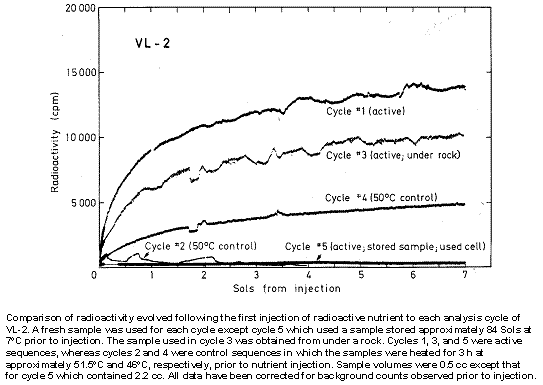
FIGURE 6. All
VL 2 cycles
6.
THE STANDARD MODEL SPECIFIC OBSTACLES RAISED AND REBUTTALS
Obstacles raised against acceptance of the LR data as proof
of life, and the problems with each follow:
a.Failure to detect organics.
The Viking organic analysis instrument (GCMS), an abbreviated gas
chromatograph-mass spectrometer designed to identify the organic material
widely presumed to be present on Mars, found no organic molecules.[3] Based on this result, the strong consensus of
the space science community was that the LR positive responses were not of
biological origin. However, the GCMS
Experimenter disclaimed his instrument as a life detector, saying as much
organic matter as in 1 billion bacterial cells were required for a result[4]. Subsequently, it was reported[5] that
several problems with the GCMS flight-type instrument further depleted its
sensitivity. Upon announcing the
detection of organic matter in the ALH4001 Martian meteorite, a NASA official
explained that the Viking GCMS had not been sensitive enough to detect the
level of organics found by the full-scale GCMS instrument by which the Martian
meteorite was analyzed. It has also been
shown[6] that the
temperature applied in the Viking GCMS fell short of that needed to vaporize
some heat-stable organic molecules in living cells, which, it was claimed,
could explain the failure of the Viking GCMS to detect organic matter. Corrections designed to fix this problem, and
to provide greatly increased sensitivity have been incorporated into newly
designed planetary probe GCMS instruments.
It is interesting to note that Viking, itself, produced evidence that
organic matter is constantly forming on Mars, and is not destroyed by a strong
oxidant. The Pyrolytic Release (PR)
experimenters reported[7]
“The data show that a fixation of atmospheric carbon occurs in the surface
material of Mars under conditions approximating the Martian ones.” In the experiment, Martian soil was exposed
to simulated Martian atmosphere containing labeled CO2 and CO. After 120 hours, any non-fixed carbon gas was
driven off by heat. Then, upon heating
the soil to pyrolysis temperature, any carbon that had been fixed was vaporized
into the headspace. Statistically
significant amounts of labeled carbon gas were evolved from the Martian soil,
providing evidence that fixation had occurred (but in insufficient amount to
support a claim for biology). The
formation and the persistence of the organic matter throughout the length of
the experiment are evidence against the presence of the oxidant(s) or any other
characteristic of the soil that would destroy all traces of organic
matter. The PR Experimenters reported[8] “Our findings suggest that UV presently reaching the Martian
surface may be producing organic matter . . . the amount of product found could
be considerable over geologic time.”

FIGURE 7. The Viking Magnetic Properties experiment
b.Strong Oxidant. When, as stated
above, sampling soil from under a rock on Mars demonstrated that UV light was
not responsible for the apparent absences of life and organic matter, the
presence of hydrogen peroxide and/or other strong oxidant(s) in the soil was
proposed instead. This hypothesis was
made despite findings by the Viking Magnetic Properties Experiment (Figure 7) that the surface material of Mars contained
a large magnetic component, evidence against a highly oxidized condition.[9] The authors of the Viking Magnetic Properties
paper concluded: “The possibilities as to the nature of the magnetic particles
detected on Mars are here summarized.
Some or all could be (1) highly magnetic, unoxidized mineral grains
(metallic Fe, magnetite, pyrrhotite) forming the core beneath a reddish coating
of limionite or hematite;” and added several lesser possibilities, none of
which could render the surface material highly oxidizing. The evidence against an oxidant provided by
the PR, discussed immediately above, was also disregarded by the pro-oxidant theorists. Since Viking, two Earth-based IR
observations, by the ESA orbiter[10]
and, most recently, data from the Rover Opportunity (Figure 8) have shown Mars
surface iron to be not completely oxidized (ferric), but to occur mostly in the ferrous form. Thus, it is difficult to make a case for the
existence of an ubiquitous strong oxidant that destroys all organic matter on the surface of Mars,
or even its presence at both Viking landing sites to account for the LR
positive results.
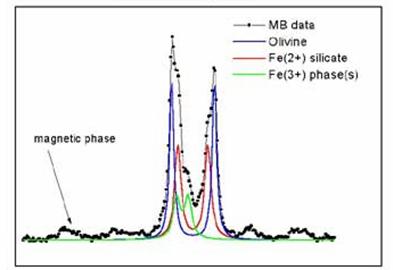
FIGURE 8. Evidence of non-completely oxidized iron on Mars
c. “Too much too soon.” The LR positive responses, and the
reaction kinetics were said to be those of a first order reaction, without the
lag or exponential phases seen in classic microbial growth curves, all of which
argued for a simple chemical reaction.
However, Figure 9 shows terrestrial LR experiments on a variety of soils
which produced response rates with the kinetics and the range of amplitudes of
the LR on Mars.
d.Second Injection. Second injections of nutrient
produced no new evolution of gas, but, instead, quickly reduced the amount of
gas accumulated from the first injection by about 20%. Although 2nd injection
responsiveness was not part of the LR life detection criteria, the lack of a
new surge of gas upon injection of fresh medium was subsequently cited as
evidence against biology. However, a test of bonded, NASA-supplied
Antarctic soil No. 664, containing less than 10 viable cells/g[11], showed this type of response to a 2nd
injection as seen in Figures 10a and 10b. (The high initial cpm of the sterile Antarctic
soil reflects residual gas in the test cell used. This does not interfere with the
demonstration of the effect of the 2nd injection.) Thus, the failure of the 2nd
injection to elicit a response can be attributed to the organisms in the active sample
having died sometime after the 1st injection, during the latter part
of Cycle 1. The effect of the 2nd
injection was to wet the soil, causing it to absorb headspace gas. The gradual re-emergence of the gas into the
headspace with time seems to have occurred as the system came to equilibrium.

FIGURE
9. Comparison of Terrestrial and Mars LR
Active Responses
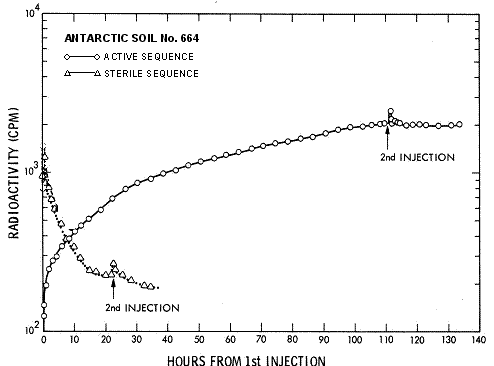
FIGURE 10a. Effect of 2nd
injection on Antarctic soil.
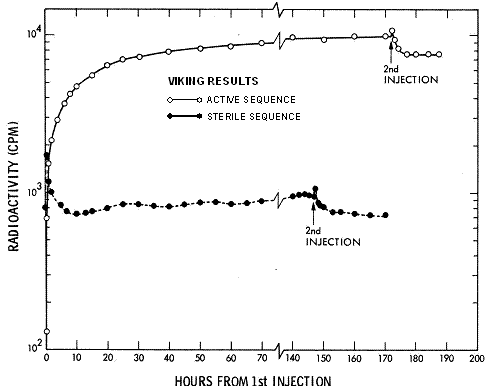
FIGURE 10b.
Effect of 2nd injection on Mars soil.
e.“No liquid water, no life.”
This contention is the primary one now cited by those not ready to
accept the discovery of life by Viking’s LR.
However, Viking, itself, gave strong evidence[12] of the
presence of liquid water when the rise in the temperature of its footpad,
responding to the rising sun, halted at 273o C. Snow or frost is seen in Viking images of the landing site (Figure 11).
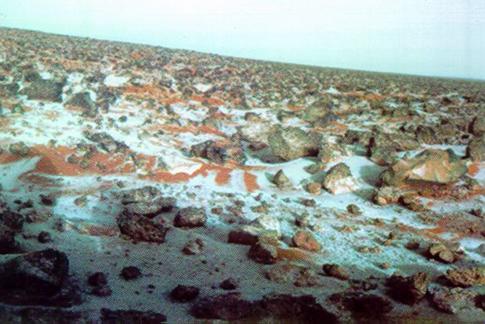
FIGURE 11.
Heavy frost or
snow at VL-2 Lander site (Viking Lander Image 21I093)
Together, these observations
constitute strong evidence for the diurnal presence of liquid water. Theoretical modeling[13],[14]
and direct experimental evidence has been cited[15]
that demonstrated liquid water occurring under Martian conditions. Odyssey has shown that much of Mars,
including the two Viking landing sites, contains moderate to large amounts of
hydrogen (interpreted as water, but called “ice”), much more than found in the
Death Valley LR tests, within several centimeters of the Martian surface. Pathfinder has shown that the surface atmosphere
of Mars exceeds 20o C part of the day, providing transient
conditions for liquid water. The Spirit
and Opportunity Rovers have taken images that suggest moist soil as seen in Figure 12. In
explaining the stickiness of the soil, MER scientists have said that it “might
contain tiny globules of liquid water,” or “might contain brine”[16].
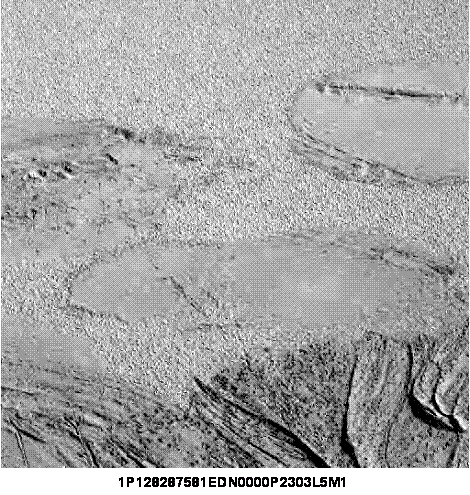
FIGURE 12.
Mud puddles on Mars?
Other
images of Mars, such as Figures 13 and 15c,
show current, if intermittent, rivulet activity. The mounting evidence for liquid water on
Mars has resulted in an emerging belief that there may be pockets of liquid
water beneath the surface, constituting oases for life. However, there is no support of the life
oases theory on Earth. Virtually the
entire surface of our planet is inhabited by living microorganisms. NASA, despite declaring its “follow the
water” route to finding life on Mars, has not sent a liquid water detection
instrument there. Indigenous
microorganisms have been found growing on the Earth’s South Polar Cap,[17] as seen
in Figure 14, and within permafrost in the Arctic.[18] However, there is liquid water even in those
frozen places. Very thin films of liquid water exist among the interstices of
ice and minerals, enough to sustain an ecology of those highly evolved species.
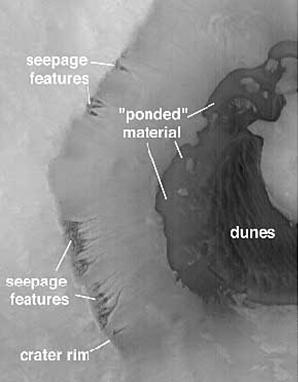
FIGURE
13. Mars Global Surveyor Image. NASA
Scientists propose that liquid water may currently seep from the walls of this
unnamed crater in the planet’s southern hemisphere. Photo courtesy of NASA.
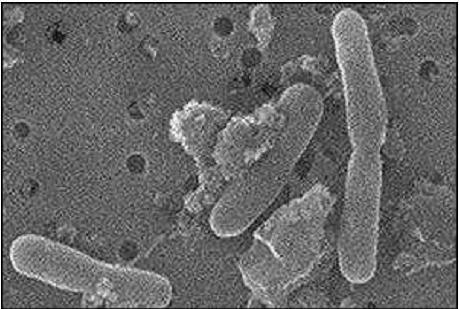
FIGURE
14. Microbes at South Pole. Researchers have
found evidence that microbes live in the ice at the Southern Pole. BBC News
Online, science editor Dr. David Whitehouse, July 10, 2000.
Desert Varnish.
In 1979, the author’s attention was called[19] to the
possible presence of desert varnish on some of the Martian rocks. Desert varnish had been reported [20] as
being of microbial origin or containing products produced by
microorganisms. Since then, many
additional articles[21],[22],[23],[24] have commented on the causal
relationship between desert varnish and microorganisms. Details of the formation and composition of
rock (desert) varnish and its specific potential relevance to extant life on
Mars have been described[25]. Figure 15 shows what appears to be desert
varnish on rocks at a Viking landing site.
A recent news article[26]
reports rekindled interest in desert varnish as evidence of life on Mars.
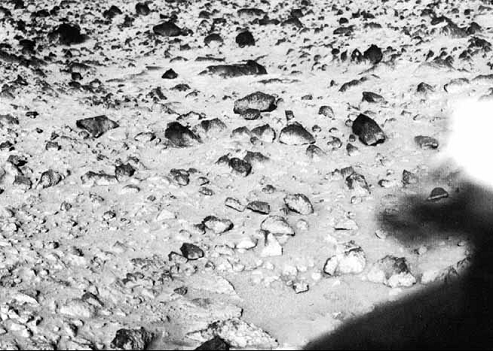
FIGURE
15. Possible desert varnish on Mars. Front-lighted rocks at Viking landing site
show glistening sheen that may be desert varnish. NASA Image, Credit: Barry
DiGregorio
Circadian
Rhythm. Re-examination of the kinetics of the
LR Mars response indicated a possible biological component. It has been proposed[27],[28] that
the kinetics of evolution of labeled gas in the Viking LR experiment might be
attributed to circadian rhythm, a universal biological phenomenon of all known
living organisms. While indications of
circadian rhythm were detected in the Viking LR data, they did not reach the
point of strong statistical significance in the two papers cited. However, another paper[29] , using
a non-linear approach, concluded, “Our results strongly support the hypothesis
of a biologic origin of the gas collected by the LR experiment from the Martian
soil.” Additional work is underway to
verify statistical significance for that conclusion.
Atmospheric Indicators.
Adding to this rising tide of facts supporting the detection of life by
the Viking LR experiment are the recent findings in the Martian atmosphere of
methane, formaldehyde, and, possibly ammonia[30],[31],[32],[33],
gases frequently involved in microbial metabolism, and, therefore, possible
indicators of life. The methane occurred
in amounts not deemed adequate for replacement of this short half-lived,
UV-labile gas since volcanic activity, a potential non-biological source of methane,
has not been indicated by thermal mapping of the entire planet. In the Earth’s atmosphere, methane is
sustained primarily by biological metabolism.
Moreover, the methane detected on Mars was associated with water vapor
in the lower atmosphere, consistent with, if not indicative of, the possibility
of extant life.
7.
THE PRESENT SITUATION
Perhaps most significant in the long, tortuous history
seeking to determine what the Viking LR detected on Mars is that no condition
or property inimical to the existence of life, or, indeed, even inimical to the
survival and growth of some forms of terrestrial microorganisms, has been
reported to exist on Mars.
Over the thirty years since the landing of Viking, more than forty
attempts have been made to explain the LR results abiologically. To this date, no experiment has duplicated or
realistically approximated the Mars LR positive and control results except when
using living microorganisms.
Science is not a democratic process, and paradigm-breaking
discoveries have always been subject to skepticism and years of delay before
acceptance by the scientific community. With the failure of all proposed alternative explanations of
the Viking LR results, the time for accepting life on Mars may be on hand. The credibility of the LR results has been
significantly advanced by what has been learned about life since Viking. Life is no longer constrained to the thin,
fragile film on, above, and below the surface of the Earth, as we were taught
before Viking. We now know there is a "Biologic
Imperative" on Earth. It has
pervaded our planet’s surface, depth and atmosphere, everywhere, including
environments as hostile as some on Mars; with, perhaps, the only exception
being red hot magma. Even if life never
originated on Mars, we now know it could have been safely deposited there from
Earth and/or other sources.[34] Since testing of the constraints on viable
interplanetary transport between Earth and Mars, it has become more difficult
to imagine a sterile Mars than a living one.
In fact, it is becoming apparent that Earth and Mars may be part of the
same biosphere.
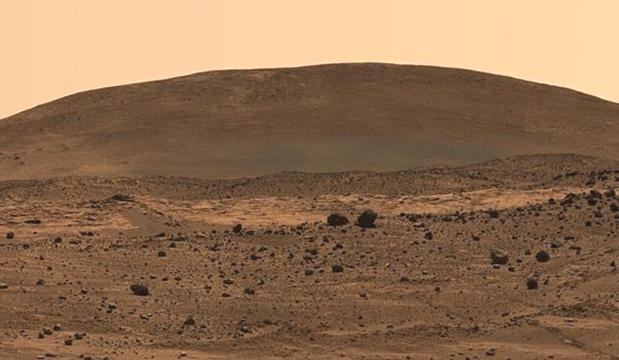
FIGURE 15b. Water on Mars?
Winter image, NASA
8.
FUTURE LIFE DETECTION EXPERIMENTS
It has been stated that newer, more modern methods should
replace the LR in future life-seeking missions.
While additional methods should certainly be sought, the abandonment of
the LR technology is contrary to the teachings of science. Whether from life or not, the LR obtained a
startling result on Mars. The scientific
method teaches that, when a new finding is made, the best and least risky way
to expand that beachhead of knowledge is to refine and re-apply the tool that
made the initial discovery.
Leeuwenhoek’s microscope, which opened the science of microbiology, was
not discarded for, say, methods seeking to detect the sounds of microbes. Leeuwenhoek’s instrument was ardently
developed into its modern descendants.
However, the LR method has been cast aside for 30 years, and the
extraterrestrial life detection methods now being developed will seek
“biomarkers,” molecules normally associated with life. However, their results, if positive, will not
pass the test of Ockham’s Razor – just as the findings of what seem to be
microbial fossils in Martian rocks did not.
Unless active metabolism is demonstrated, it is unlikely that any
experimental results will overcome scientific skepticism.
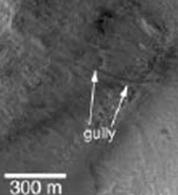
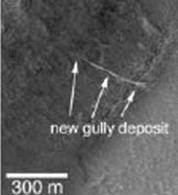

FIGURE
15c. Recent gully activity on Mars
surface. Comparation between December 22, 2001, and August 26, 2005 (top threee
images) in the northwest wall of a crater in Terra Sirenium. Next two images: a
landscape in a crater in the Centauri Montes region on August 30, 1999 (left)
and September 10, 2005. Final two images: details of the latter surface
activity. Nature of the seemingly acqueous flood is not yet ascertained. Images
made public in Nov. 2006, after the author's original lecture. Credit:
NASA/JPL/MSSS /Science
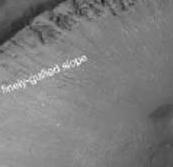
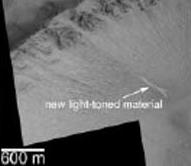
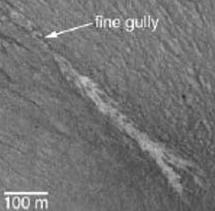
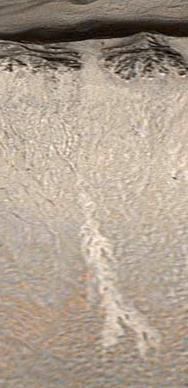
Most lamentable is the fact that no life detection test has
been sent to Mars since Viking, nor even an experiment to confirm or identify
the “strong oxidant,” that produced the LR signal on Mars. The confirmation of such a surprising
chemical activity of the surface of Mars would, itself, constitute a major
scientific finding, which should have been sought in landings subsequent to
Viking. Furthermore, the data from the
one billion 1976 dollars spent on Viking have not yet been objectively reviewed
for evidence of life. No credible
scientific refutation of the LR results has been published, yet subjective
statements such as “The scientific community does not accept the LR results as
evidence for life” are commonplace.

FIGURE 16.
Twin Wireless Extraterrestrial Experiment for Life
(TWEEL) on rover.
A logical next step in pursuing the life on Mars question is
the chiral adaption of the LR experiment, which builds on that experiment’s
legacy rather than abandon it. All known
forms of life exhibit an exclusive or very strong preference for “left-handed”
amino acids and “right-handed” carbohydrates over their respective enantiomers. The Chiral
LR experiment to detect active chiral metabolism, photosynthesis and circadian rhythm is shown
in Figures 16 and 17. While any chemical or “biosignature” can be
refuted through the application of Ockham’s Razor, the demonstration of active
metabolism by any of these three methods would constitute indisputable proof of
life. The Chiral LR experiment could not
only prove the existence of life to even the most resistant to the Mars LR
results, but could determine whether that life is related to ours. The most exciting result would be finding
that it is not, thereby demonstrating a second, independent genesis, strongly
implying that life must be plentiful throughout the universe - another
paradigm-breaker. I have proposed the
Chiral LR experiment to various space agencies many times, formally and
informally, without its acceptance. Here
and now, I propose it again.

FIGURE 17. Twin Wireless
Extraterrestrial Experiment for Life (TWEEL)
Chiral LR/Circadian Rhythm/Photosynthesis Life
Detection Experiment
9.
RECOMMENDATIONS
On the
basis of the case for life on Mars as set forth above, and in greater detail on
the website spherix.com/mars, the following
recommendations are made in the interest of answering this paramount scientific
question:
a.
A panel of independent scientists should be convened to study
the Viking LR results and all other data bearing on the life issue. A full report of the findings and conclusion
should be rendered. To date, there has
been no formal peer review of this experiment and related data, with the
negative conclusion having been rendered and promulgated by only several Viking
scientists prior to publication by the Experimenters.
b.
Every spacecraft henceforth sent to land on Mars should carry
a life detection test.
c.
The Chiral LR/Photosynthesis/Circadian Rhythm experiment
should be sent to Mars at the earliest opportunity.
d.
Images of the same areas of Mars taken at different time
intervals should be compared for temporal variations as evidence suggestive of
liquid water. The suggestive images
should also be compared with other types of Martian data in order to seek
correlations with atmospheric water vapor, temperature and seasons. Life-suggestive color and pattern changes in
the same features imaged at different times should be sought in the many images
of the surface of Mars taken by orbiters, the Hubble Telescope, Spirit and
Opportunity.
ACKNOWLEDGEMENTS: The author wishes to acknowledge and
thank NASA for funding the LR experiment from 1959 to 1979; Dr. Patricia A.
Straat, Viking Labeled Co-Experimenter, whose efforts were indispensable to the
development and flight of the LR experiment; Dr. Richard Hoover, NASA MSFC, for
inviting and encouraging the author to present papers at the Astrobiology
Conferences convened by the International Society for Photonics and Optical
Engineering (SPIE); Mrs. Kathy Brailer, the author’s Executive Assistant of
many years, who helped immeasurably in preparing this manuscript. Spherix
Incorporated for supporting his efforts subsequent to NASA funding.
_______

revista
Electroneurobiología
ISSN: ONLINE 1850-1826
- PRINT 0328-0446
* This article, Dr. Levin's contribution to the 2006 International Symposium on Optical
Science and Technology of the Society of Photo-Optical Instrumentation
Engineers (SPIE), originally appeared as "Modern myths of Mars" in Instruments, Methods, and Missions for
Astrobiology IX: Proceedings of the Society of Photo-Optical
Instrumentation Engineers (SPIE), vol. 6309, 63090C (2006). Received 11/19/2006.
[1] Levin, G.V. and P.A.
Straat, “Completion of the Viking Labeled Release Experiment on Mars,” J. Mol. Evol. 14, 167-183, 1979.
[2] Cameron, R.E. and R.E. Benoit, Ecology 51, 801, 1970. See
also Antarctic Soil No. 715.
[3] Biemann, K. et al., “The Search for Organic Substances and
Inorganic Volatile Compounds in the Surface of Mars,” J. Geophys. Res. 82,
28, 4641-4662, 1977.
[4] Biemann, K., Viking Science Press Conf. Sept. 4, 1976, JPL.
[5] G. Levin, L. Kuznetz, and A. Lafleur, “Approaches to resolving
the question of life on Mars,” Instruments,
Methods, and Missions for Astrobiology, SPIE Proceedings 4137, 48-62, 2000.
[6] Benner, S., quoted in New Scientist article, “Buried
Evidence,” March 24, 2000.
[7] Horowitz, N.H., G.L. Hobby and Jerry S. Hubbard, “Viking on
Mars: The Carbon Assimilation Experiments,” J. Geo. Res. 82, 28,
4659-4662, 1977.
[8] Hubbard, J.S., J.P. Hardy, G.E. Voecks and E.E. Golub,
“Photocatalytic Synthesis of Organic Compounds from CO and Water: Involvement
of Surfaces in the Formation and Stabilization of Products”,
J. Mol. Evol. 2, 149-166, 1973.
[9] Hargraves, R.B., D.W. Collinson, R.E. Arvidson and C.R. Spitzer,
“The Viking Magnetic Properties Experiment:
Primary Mission Results,” J.
Geophys. Res. 82, 4547, 1977.
[10] Kerr, R.A., “Life or Volcanic Belching on Mars?” Science 303,
5666, 1953, 26 March 2004.
[11] Quam,
L.O., ed., Research in the Antarctic, AAAS #93, Wash., DC, 1971.
[12] Moore, H.J. et al., “Surface Materials of the Viking
Landing Sites,” J. Geophys. Res. 82:28, 4497-4523, 1977.
[13] Levin, G.V. and R.L. Levin, “Liquid Water and Life on Mars,” Instruments,
Methods, and Missions for Astrobiology,
SPIE Proceedings 3441,
30-41, July, 1998.
[14] Hecht, M., “Aqueous environments on contemporary Mars,” Instruments,
Methods, and Missions for Astrobiology IV, Proceedings of SPIE 4495,
69-80, 2001.
[15] Op. cit. (5).
[16] “Mars rovers explore hints of salty water: Water one of several
theories proposed,” by Robert Roy Britt, SPACE.com, February 19, 2004,
[17] Carpenter, E.J., S. Lin, and D.G. Capone, “Bacterial Activity in
South Pole Snow,” Applied and Environmental Microbiology 66, 10,
4514-4517, 2000.
[18] Skidmore, M.L., J.M. Foght, and M.J. Sharp, “Microbial Life
beneath a High Arctic Glacier,” Applied and Environmental Microbiology 66,
8, 3214-3220, 2000.
[19] Henry Moore to Gilbert Levin, personal communication, reported in Mars: The Living Planet, Barry
DiGregorio, Frog, Ltd., Berkeley, CA, p. 70, 1977.
[20] Schwabe, A., “Blaualgen aus ariden Boden,” Fortsch.
u. Fortschr. 34, pp.
194-197, 1960.
[21] Dorn, R.I., and T.M. Oberlander, “Microbial origin of desert
varnish,” Science 213, p. 1245-1247, 1981.
[22] Flood, B.E., C. Allen, and T. Longazo, “Microbial fossils detected
in desert varnish,” Astrobiology 2(4), 2003.
[23] Probst, L.W., C.C. Allen, K.L. Thomas-Keprta, S.J. Clemett, T.G. Longazo,
M.A. Nelman-Gonzalez, and C. Sams, “Desert varnish - preservation of biofabrics
and implications for Mars,” Lunar and
Planetary Science 33, 1764,
2002.
[24] Spilde, M.N., “Subterranean
manganese deposits in caves: analogies to rock varnish?,” Geological Society
of America, Paper No. 216-13, Denver Annual Meeting, 2002.
[25] DiGregorio, B., “Rock Varnish as a Habitat for Extant Life on
Mars,” Instruments, Methods, and Missions
for Astrobiology, SPIE Proceedings
4495-13, 2001.
[26] Sherriff, L., “Shiny rocks could hold evidence of Martian life,” The
Register, July 4th, 2006.
[27] Case, M., A. Dini, G.V. Levin, P.A. Straat, H.P.A. Van Dongen, and
J.D. Miller, “Circadian rhythms and evidence for life on Mars,” Instruments, Methods, and Missions for
Astrobiology, SPIE Proceedings 5555, 35, August 2004.
[28] Van Dongen, H., J. Miller, P. Straat and G. Levin, “A circadian
biosignature in the Labeled Release data from Mars?” Instruments, Methods, and Missions for Astrobiology, SPIE Proceedings 5906, OC1-10, August 2005.
[29] G. Bianciardi, “Nonlinear Analysis of the Viking Lander 2 Labeled
Release Data,” Proc. of the III European Workshop on Exo-Astrobiology on Mars:
The search for Life, Madrid, Spain, 18-20 November 2003 (ESA SP-545, March
2004).
[30] Op. cit. (10).
[31] Howe, L., “Formaldehyde, Ammonia, and Benzene Molecules on Mars?
Would Probably Mean Life,” www.earthfiles.com/news/printerfriendly.cfm?id=707
).
[32] Krasnopolsky, V.A., J. P. Maillard, and T. C. Owen, “Detection of
Methane in the Martian Atmosphere: Evidence for Life,” European Geosciences
Union, 1st General Assembly, Nice, France, April 25-30, 2004.
[33] Whitehouse, D., “Ammonia may have been found in Mars' atmosphere
which some scientists say could indicate life on the Red Planet,” Online
Science Ed., BBC, reported in BBC News, July 15, 2004.
[34] Levin, G., “Scientific Logic for Life on Mars,” Instruments,
Methods, and Missions for Astrobiology, SPIE Proceedings 4495, 81-88, July 2001.